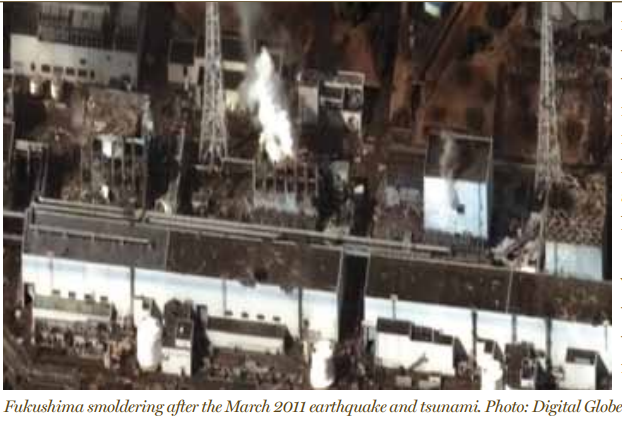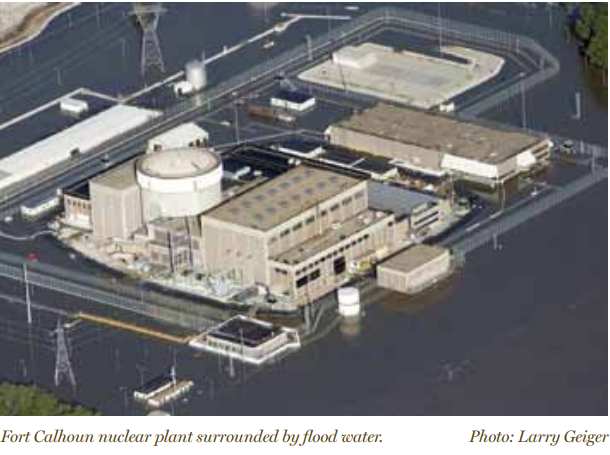How Many Wake-Up Calls Does it Take?
Three Mile Island (TMI). Chernobyl. Fukushima.
After TMI, nuclear industry advocates told us not to worry, they had brought the accident under control a half-hour before a complete meltdown and breach of the reactor vessel would have occurred.
After Chernobyl had a complete meltdown (and fire) they told us not to worry, it was a Soviet-design reactor, different than ours.

But what can they say in the wake of the Fukushima disaster, which, as I write, is still going on? These were General Electric-designed plants, in a technologically advanced society, with a regulatory structure similar to our own.
They still say: not to worry. It can’t happen here. But it can. How many warnings must occur before we come to our senses?
What happened at Fukushima is called “station blackout”—a reactor loses offsite power to run the pumps to cool the fuel to prevent it melting, and the backup diesel generators fail as well. When nuclear fuel melts, it releases vast quantities of radioactivity. What happened at Fukushima can occur here. There are numerous ways one can lose cooling at any American reactor. In the months after the earthquake and tsunami hit Fukushima, we had a series of remarkable close calls here. Yet American authorities continue to repeat their Alfred E. Neuman refrain: What, me worry?
Less than two weeks after the quake took down Fukushima’s offsite power and the tsunami damaged its backup diesels, powerful tornados tore across the American Southeast. The tornados destroyed transmission lines taking electricity to three reactors at TVA’s Browns Ferry plant in Alabama—site of a famous near-catastrophe in the 1970s—causing the reactors to lose offsite power. Not to worry: the backup diesel generators kicked in. Then one developed a leak of hydraulic oil and had to be shut down, resulting in loss of cooling to two reactors for a time. A few days later, a second diesel generator failed. Eventually, offsite power was restored. A close call. A warning.
A couple of months later, a fire damaged electrical equipment needed to cool the irradiated reactor fuel storage pool at the Ft. Calhoun nuclear plant in Nebraska, causing the highly radioactive fuel to lose the pumps needed to cool the fuel for about an hour and a half. Eventually the pumps were restored.

But a few weeks thereafter we were faced with stunning footage of the Ft. Calhoun plant, and the Cooper Nuclear Station, also in Nebraska, surrounded by rising flood waters, as though sinking in the center of a huge lake. At the Ft. Calhoun atomic reactor, the waters were being held back from the plant by what was for all intents and purposes a huge black rubber inflatable inner tube surrounding the facility—that is, until someone operating a Bobcat accidentally punctured it, causing it to deflate.
The chairman of the Nuclear Regulatory Commission, Greg Jaczko, visited in an effort to reassure the public. When he arrived at the plant, completely surrounded by flood water, The New York Times reported, he was offered a life jacket! He had to climb over piles of sandbags to get from one part of a building to another. As nuclear engineer Ernie Gunderson quipped, the words “sandbag” and “nuclear reactor” should never be in the same sentence.
Again, another major warning. You’d think Someone was trying to tell us something, but we still weren’t getting the message.
And yet, there was one more opportunity given us to see the light: In late August, a major earthquake rocked the East Coast. Thirteen reactors felt it, but the greatest impact was to the North Anna plant in Virginia. Huge irradiated fuel casks shifted due to the quake. Offsite power was lost. One of the backup diesel generators failed an hour later.
The plant operators said, not to worry, that the ground motion at North Anna was less than the plant was designed for. Eventually it was revealed that the seismic shaking was, in fact, twice as high as the utility and the NRC had deemed credible when the plant was licensed and the reactor was designed. It was an earthquake greater than they had claimed could ever occur—just as the Fukushima quake was larger than what those authorities had said the plant needed to be designed for. Again, we lucked out, but only a fool would keep spinning the chamber of a gun in Russian roulette and pulling the trigger another time.
Were there a Jerry Falwell of environmental theology perhaps she or he would be thundering about a people who were deaf to repeated divine warnings. The Japanese, Germans, Swiss and Italians all, in the wake of Fukushima, decided to move away from nuclear power and transition to safe, clean renewables. But as in so many other things, reality seems to stop at the American shore.
The American public has taken heed of the warnings. Support for more nuclear power is very low. But decision-makers, people in power—the recipients of large contributions from the nuclear industry—seem to be blind to reality and continue to press for ever more taxpayer subsidies for more atomic plants, no matter what the public wishes or the evidence mandates. With all the focus on the failed Solyndra solar company that received a bit more than $500 million in federal loan guarantees, not a word has been said about the loan guarantees being doled out in amounts over $5 billion – ten times higher – for new nuclear plants.
And yet, what kind of fools are we if we do not alter course, while there is still time, in the wake of these repeated indicators of pending danger? There is still time. The next accident will not be identical to Fukushima. As the saying goes, history doesn’t repeat itself, but it does rhyme. The accident that may hit San Onofre and contaminate hundreds of thousands of people in Southern California, or destroy Diablo Canyon and whose radioactive plume could potentially wipe out California’s agricultural heartland in the Central Valley, or melt Indian Point and put at risk millions of people in New York, won’t be precisely like the disaster that so devastated Fukushima. But Fukushima—and Browns Ferry, Ft. Calhoun, and North Anna thereafter— were warnings only fools would ignore.